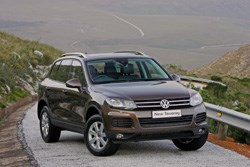
Top stories






LegalKenyan court postpones case seeking to halt Diageo's $2.3bn sale of EABL
Duncan Miriri and Emma Rumney 1 day
More news












The magic wand in this case is VW's environmentally friendly BlueMotion range of technologies which is spread across a number of models in the VW fleet, including the sleek and handsome Volkswagen CC 2.0-litre TDI in which my wife and I, plus all our luggage and kit for a two-week road trip to Addo and the Baviaanskloof, travelled in.
BlueMotion technology on board the 125kW/350Nm CC include a stop/start system and battery regeneration that recovers braking energy. According to VW a combined fuel consumption of just 5.5 litres/100km is achievable in ideal conditions, coupled to emissions of just 144g/km.
We got very close to the claimed figure, even though I opened the taps quite a bit on that lovely winding road down to Gordon's Bay.
Our CC test car has a 125kW/350Nm engine linked to a 6-speed DSG transmission - a combination which works efficiently enough to return a 8.6 second sprint from 0-100km/h and a top speed of 220km/h. It also has a lovely Sport button which speeds the action up a bit when you feel like growing horns.
The standard CC retails for R377,500 but our test car was loaded with nine optional extras (including a panoramic sunroof, rear view camera, Satnav and Nappa leather seats with active climate system) which pushed the price up to R451,070.
The CC is an attractively styled four-door coupe with enough space for four big adults and luggage space of 532 litres.
BlueMotion technology was first introduced in 2010 in the Polo BlueMotion which became the first five-seater in the world to consume less than 4.0 litres/100km.

Since then VW has also launched Golf, Touareg, Tiguan and CC models with BlueMotion technology on board and most recently Polo Vivo (the best-selling passenger model in South Africa in 2012) added a Blueline derivative in its model line-up. Blueline is equipped with some of the BlueMotion standard features such as lower rolling resistance tyres, longer gear ratios and aerodynamic improvements.
In essence BlueMotionTechnologies is the umbrella description of a range of innovations geared to improve fuel economy and reduce emissions such as the TDI (turbo diesel direct injection) and TSI (boosted petrol direct injection) engines as well as Direct Shift Gearbox (DSG).
They are supplemented by technological innovations that include drive systems such as EcoFuel (natural gas engines), BiFuel (liquid natural gas engines), MultiFuel (ethanol), hybrids and electric drives as well as NOx emissions control, regenerative braking and a Stop-Start system.
These basic technologies and innovations are being adopted in a number of Volkswagen products under the headings of BlueMotion, BlueMotion Technology, BlueTDI and TSI EcoFuel. Currently only the BlueMotion and BlueMotion Technology brands are available in South Africa.
BlueMotion represents the most fuel-efficient Volkswagen model in the range. These models are class leaders in terms of fuel economy and emissions. Building the foundation for the extremely low fuel consumption and emissions values of the BlueMotion models are common rail TDI engines with modified engine management software and reduced idling speed.
BlueMotion features include gear shift indicator, braking energy (regenerative braking), a Stop-Start system, low-rolling resistance tyres, lightweight and aerodynamic wheels and lowered suspension. They carry the BlueMotion logo on their radiator grille and rear.

In South Africa, Polo and Golf, two key high-volume models for Volkswagen South Africa, come with a package that includes common rail TDI engines, recovery of braking energy by regenerative braking, a Stop-Start system, low resistance tyres and refined aerodynamic components. Both these cars are amongst the most fuel-efficient models in their classes.
Polo BlueMotion has a combined fuel consumption of just 3.4 litres diesel (equivalent to 89g/km CO2) /100km. In time, it targets to be the "3-litre fuel economy car" of the modern era and one of the most economical five-seaters in the world. Its 45 litre fuel tank has a potential driving range of nearly 1,200km.
Only marginally less economical than the Polo is the new Golf BlueMotion. Thanks to a diesel fuel consumption of just 3.8 litres/100km and emissions value of 99g/km CO2, Golf BlueMotion is also one of the most fuel-efficient cars in its class. It has a theoretical driving range of approximately 1,300km on a 55 litre tank.
The BlueMotion Technologies aboard the two cars include their common rail TDI engines with modified engine management software and reduced idling speed. At the heart of the Polo BlueMotion is a 1.2-litre TDI (55kW) with three cylinders, while the Golf is powered by a 1.6-litre TDI (77kW) with four cylinders.
A gear-shift indicator integrated in the instrument cluster shows the most energy-efficient gear for the current driving conditions. Other BlueMotion features include recovery of braking energy (regenerative braking), a Stop-Start system, low rolling resistance tyres, special lightweight and aerodynamic wheels, lowered suspension (on the Golf).
Vehicles with BlueMotion Technology offer individual configuration options and can be identified with a rear BlueMotion Technology badge. These vehicles are equipped with fuel efficient TDI and TSI engines. A Stop-Start system and regenerative braking are standard features in models with BlueMotion Technology. Touareg, CC and Tiguan are offered under this concept brand.

The 3.0 V6 TDI Touareg with BlueMotion Technology (180kW) engine has a Stop-Start system as standard equipment; the powertrain also utilises regenerative braking to recover kinetic energy. The common rail turbodiesel consumes a 7.2 litres/100km (equivalent to 189g/km CO2).
The Volkswagen CC we travelled in down the coast is equipped with 2.0 TDI (125kW) engine with BlueMotion Technology. The TDI engine features Stop/Start system and a battery regeneration mode (which recovers braking energy). Its combined fuel consumption is just 5.5 litres/100km (144g/km CO2).
Tiguan is the only model that offers BlueMotion Technology in both TSI and TDI engines. The Tiguan 1.4 TSI 90kW with BlueMotion Technology (Stop/Start system and battery regeneration) is the most fuel-efficient petrol engine in the new Tiguan range with a combined fuel consumption of 6.5 litres/100 km (equivalent to 152g/km CO2).
The 1.4 118kW TSI with a turbo- and supercharged engine has a combined fuel consumption of 6.7 litres/100km (equivalent to 156g/km CO2).
The 2.0 TDI kicks out 81kW and its engine benefits from common rail injection and turbocharger which translates into a combined fuel usage of 5.3 litres/100km (equivalent to 139g/km CO2).

Polo Vivo Blueline, which was added to the best-selling Polo Vivo model range recently, is a special development only available in South Africa. Standard features include lowered suspension, longer gear ratios, lower rolling resistance tyres, aerodynamic dynamic improvements and engine management software.
Polo Vivo Blueline, which is offered in the hatch and sedan body versions, has a 1.4 55kW engine which returns a combined fuel consumption of 5.4 litres/100km (128g/km of CO2).
I drove all the above models, accept for the Polo Vivo, on the long stretch between Port Elizabeth and Cape Town, including a coastal swing to Gansbaai and an overnight in George and was impressed by its sip-sip thirst in spite of enthusiastic accelerator prodding.
I liked the fact that the vehicles have no in-your-face nurse maids and waving electronic fingers to reprimand you for stomping on the loud pedal too hard or for not changing up a notch to save a drop or two.
Blue Motion and BlueMotion Technology deliver environmentally friendly assistance to the driver without flashing lights or electronic nags or moans and without making drivers feel like criminals or polar bear killers when they want to have a bit of fun with the right foot pedal - and that's what makes these VW blue cars nicer to own and drive than just about every other green car on the local market.
